New Delhi: Scientists have discovered ancient water droplets trapped in rocks in the Himalayas that can help explain the events that led to the evolution of life 500-700 million years ago — how Earth moved to the Neoproterozoic Oxygenation Event, a key period when life evolved from unicellular to more complex forms.
In a study published in the journal Precambrian Research, scientists from the Indian Institute of Sciences (IISc), Bengaluru, and Niigata University of Japan explain how they found ocean water and freshwater droplets in crystalline magnesite rocks in the Himalayas.
These droplets date back to the Snowball Earth glaciation, a period in history when the Earth was covered in glacial ice formations. After the glaciation period came the Second Great Oxygenation event when a lot of oxygen was produced and released into the atmosphere and oceans. Both the periods were a part of the Neoproterozoic era.
The oxygenation event was key as it led to the evolution of our present life on Earth. This process, from glaciation to oxygenation, was little understood by researchers because of lack of evidence like well-preserved fossils, and due to the disappearance of all past oceans. But they knew its importance in contributing to new life forms.
But now, with this new evidence, researchers have been able to assess the composition of ancient sea water and show how the glacial period gave way to a resurgence of oxygen in the atmosphere.
The team of researchers went looking for evidence across the Kumaon region or the Lesser Himalayas in Uttarakhand. Their search extended from Amritpur to the Milam glacier, and from Dehradun to the Gangotri glacier region.
“We have found a time capsule for paleo oceans,” Prakash Chandra Arya, the first author of the study, said in a statement Thursday. The rock formation where they found the ancient ocean water is Himalayan magnesite — a rare mineral that retains properties of the seawater from which it forms and settles.
The researchers found that while the deposits had both magnesium and calcium, the level of the latter was low. They attributed this to low riverine input, or low flow in the oceans. “When there is no flow or calcium input, as more calcium precipitates, the amount of magnesium goes up,” said Sajeev Krishnan, one of the authors of the study, in the statement.
This spike in magnesium due to lack of calcium in the water created nutritional deficiency which was the ground for some forms of photosynthetic bacteria to grow. Photosynthetic bacteria produce oxygen and release it into the atmosphere. “Whenever there is an increase in the oxygen level in the atmosphere, you will have biological radiation (evolution),” said Arya.
This could have led to the rise of oxygen in the atmosphere, eventually causing the great oxygenation event of the Neoproterozoic eon, concluded the study.
(Edited by Smriti Sinha)
Also read: What’s in DNA Technology Bill withdrawn by Modi govt & why House panel wanted safeguards in place



